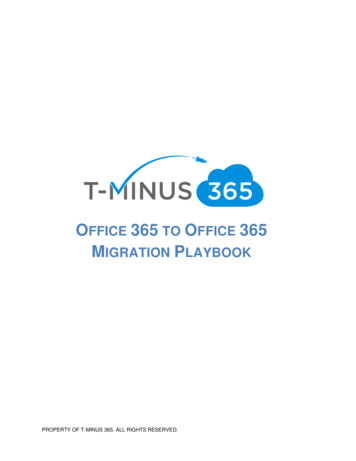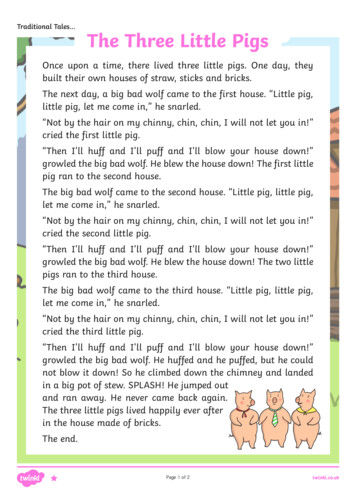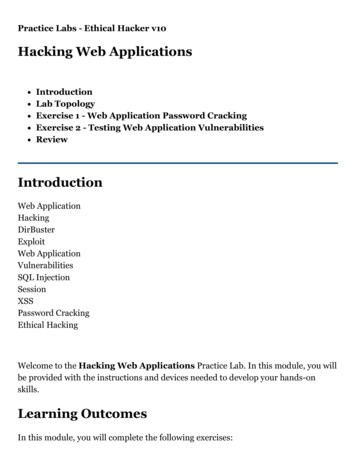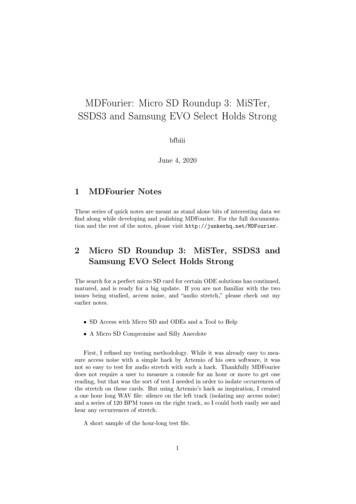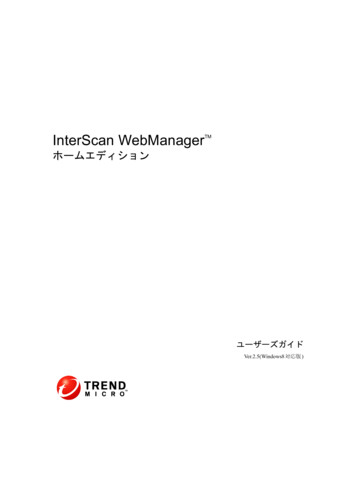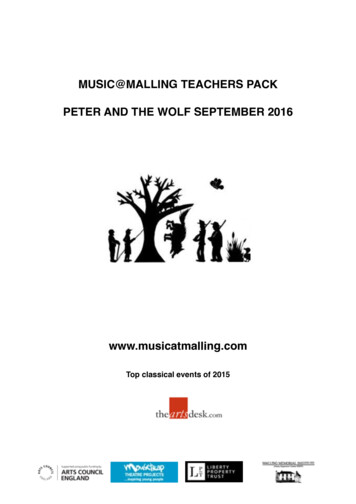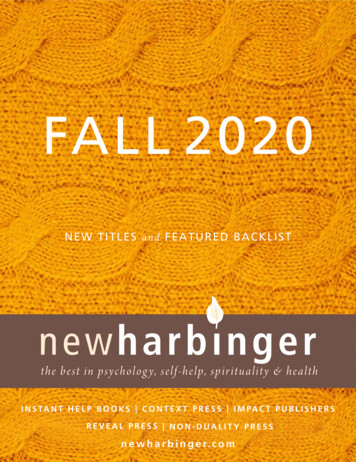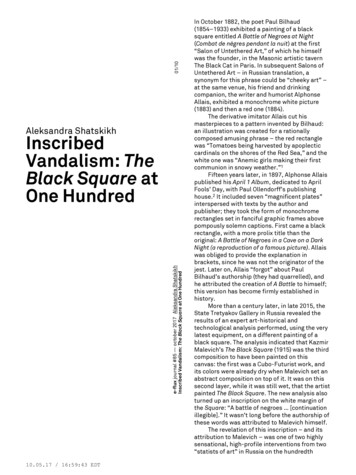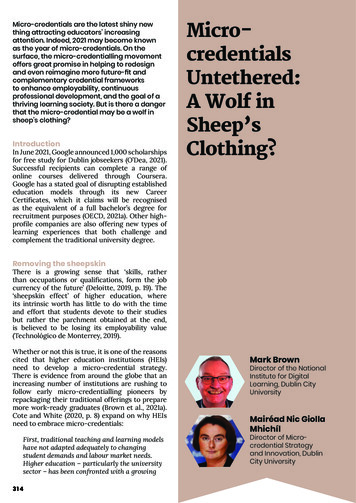
Transcription
Micro-credentials are the latest shiny newthing attracting educators’ increasingattention. Indeed, 2021 may become knownas the year of micro-credentials. On thesurface, the micro-credentialling movementoffers great promise in helping to redesignand even reimagine more future-fit andcomplementary credential frameworksto enhance employability, continuousprofessional development, and the goal of athriving learning society. But is there a dangerthat the micro-credential may be a wolf insheep’s clothing?IntroductionIn June 2021, Google announced 1,000 scholarshipsfor free study for Dublin jobseekers (O’Dea, 2021).Successful recipients can complete a range ofonline courses delivered through Coursera.Google has a stated goal of disrupting establishededucation models through its new CareerCertificates, which it claims will be recognisedas the equivalent of a full bachelor’s degree forrecruitment purposes (OECD, 2021a). Other highprofile companies are also offering new types oflearning experiences that both challenge andcomplement the traditional university degree.MicrocredentialsUntethered:A Wolf inSheep’sClothing?Removing the sheepskinThere is a growing sense that ‘skills, ratherthan occupations or qualifications, form the jobcurrency of the future’ (Deloitte, 2019, p. 19). The‘sheepskin effect’ of higher education, whereits intrinsic worth has little to do with the timeand effort that students devote to their studiesbut rather the parchment obtained at the end,is believed to be losing its employability value(Technológico de Monterrey, 2019).Whether or not this is true, it is one of the reasonscited that higher education institutions (HEIs)need to develop a micro-credential strategy.There is evidence from around the globe that anincreasing number of institutions are rushing tofollow early micro-credentialling pioneers byrepackaging their traditional offerings to preparemore work-ready graduates (Brown et al., 2021a).Cote and White (2020, p. 8) expand on why HEIsneed to embrace micro-credentials:First, traditional teaching and learning modelshave not adapted adequately to changingstudent demands and labour market needs.Higher education – particularly the universitysector – has been confronted with a growing314Mark BrownDirector of the NationalInstitute for DigitalLearning, Dublin CityUniversityMairéad Nic GiollaMhichílDirector of Microcredential Strategyand Innovation, DublinCity University
5hi gher ed uca t i o nlist of critiques to the still-dominant, campus-focused program models:long and relatively inflexible programs; inadequate recognition of priorlearning; slow or limited innovation in pedagogy; insufficient studentsupports for career-readiness; weak alignment to labour market needs;and a limited commitment to online and digital-enabled learning.Beware of the wolfIs it just another fad? In a stinging critique of micro-credentials, Ralston(2021, p. 83) argues that they are nothing more than a case of ‘learninginnovation theater’. At a deeper level, he argues that HEIs are selling theirsoul to business interests and market forces by unbundling the degree toquickly bolster their profits. According to Ralston, the emphasis on futureskills is at the expense of educating the whole person:The craze represents a betrayal of higher education’s higher purpose anda loss for students and faculty who continue to see university learning asmore than vocational training (ibid., p. 92).“The concept ofmicro-credentialsis not new. For decades,short courses have beenan essential part of adulteducation and havehad a prominent role incontinuing professionaleducation in manyprofessions.This line of critique argues that the drive to unbundlethe traditional degree can be traced to the forces of the‘neoliberal learning economy’ (ibid., p. 83). From thisviewpoint, higher education has become a form of acommodity, marketed and sold and acquired like any other.Wheelahan and Moodie (2021, p. 1), similarly, argue thatmicro-credentials are ‘gig qualifications for a gig economy’.While critique is usually a valuable source of insight,sweeping generalisations are unhelpful. Micro-credentialsare being developed in multiple contexts with a variety ofobjectives, from fulfilling lifelong learning to broadeningparticipation. They should therefore not be treated as asingle uniform entity.Charting the fieldThe field of micro-credentials is complex, and there is no global consensuson the term (Oliver, 2021). Confusing matters further, several other labelsare commonly used instead of it or interchangeably with it. Despite thisproblem, many governments have been attracted to micro-credentials aspart of their strategy to get people back to work after Covid-19 (OECD,2021b).In November 2020, for example, the provincial government in Ontario,Canada, announced 59.5 million over three years for a major microcredential development programme (Government of Ontario, 2020). Theprevious month an exciting Irish initiative was launched, with 12 millionavailable under the Human Capital Initiative to develop a national multicampus micro-credential (MC2) system over five years (IUA, 2020). Thegrowing investment in this area is evidence that ‘micro-credentials are seenas a valuable tool by institutional leaders’ (OECD, 2021b, p. 3).Interestingly, Usher (2021) describes the current attraction of microcredentials as being like ‘catnip to politicians’. While cats might be lessIRE LAN D’ S E DU C ATION YE ARBOOK 2021315
5h i g h er ed u ca tiondangerous than wolves, there is a degree of memory loss in some of theclaims about the potential of micro-credentials. After all, they are already‘huge and hiding in plain sight’ (Matchett, 2021). An Australian study foundthere were 2.6 million people already enrolled in non-qualification ‘trainingbundles’, primarily to meet regulatory requirements in workplace safety,emergency preparedness, and authority to operate (Palmer, 2021). It alsofound that this market is largely ‘private’, with largely no governmentcontribution.In Canada, the St John’s Ambulance has been offering fee-paying shortcourses in basic first aid for well over a century. In fact, these courses werefirst offered in 1833, and now more than half a million Canadians annuallyseek to complete St John’s certificates (Toronto Workforce InnovationGroup, 2021). In 2020, over 10,000 jobs posted online in Toronto were foundto have required some form of first aid training.Though we have limited data on similar courses in Ireland, the key point isthat smaller formal and non-formal training bundles have existed for manyyears. The concept of micro-credentials is not new (Oliver, 2019). Hudak andCamilleri (2021, p. 5) reiterate this point:For decades, short courses have been an essential part of adult educationand have had a prominent role in continuing professional educationin many professions. In diving instruction, vendor-led IT certification,and in medical continuing professional development, they are eventhe dominant form of education. The idea of ‘unbundling’ HigherEducation into smaller parcels, functions and courses has been frequentlymentioned in literature since at least 1975, while in European policymaking the idea of offering short courses for reskilling has been presentsince at least 2001.Credit BearingMacro-credentialsMicro-credentialsFormal AccreditedDegreesFormal & Semi-FormalAccredited & StackableCredentialEcologyBundledNon-status AwardsSemi-Formal rmal & Non-FormalDigital Badges & CertificatesNon-Credit BearingFigure 1: The new credential ecology (Brown et al., 2021a)316IRE LAND ’ S EDUCATION YEARBOO K 2021
5hi gher ed uca t i o nRemapping the landscapeAn important distinction needs to be made between older and newer typesof micro-credentials. Importantly, many of the older types appear to servedifferent purposes from traditional macro-credentials. They are oftenawarded by different types of organisations based on different standards,professional frameworks, or quality-assurance processes.To illustrate the relationships between different types of credentials,Brown et al. (2021a) attempted to map the new and emerging landscape.Figure 1 presents four credential quadrants across two axes. At one endof the y-axis, we position traditional macro-credentials and credit-bearingmicro-credentials. On the x-axis, we show the degree to which credentialsand related units of learning are bundled together by the awarding body – incontrast, at the other end, to the level of personal choice that learners haveover the make-up of their own learning bundle.In this typology, micro-credentials are differentiated from other types ofcredentials on the basis of their unbundled, credit-bearing, and stackablenature. However, the distinction between quadrants isnot as clear-cut in reality. To add clarity, the EuropeanCommission’s Higher Education Consultation Groupon Micro-credentials proposed the following truncatedA micro-credentialdefinition:is a proof of thelearning outcomes thatA micro-credential is a proof of the learning outcomes that aa learner has acquiredlearner has acquired following a short learning experience.following a short learningThese learning outcomes have been assessed againstexperience.transparent standards. (European Commission, 2020, p. 10)“This definition makes it explicit that a micro-credential is adocumented award by a trusted body to signify that a learner,upon assessment, has achieved learning outcomes of a smallvolume of learning against transparent standards and in compliance withagreed quality-assurance processes (Brown et al., 2021a).Ideally, micro-credentials should be referenced to, or embedded in, theEuropean Qualification Framework (EQF) and in National QualificationFrameworks (MICROBOL, 2021). However, our Irish national survey ofemployers shows that this definition needs to take greater account ofindustry settings and workplace training (Nic Giolla Mhichíl et al., 2021).Better plotting the literatureWhile progress has been made on the definition front, there remains a lackof data on the value of both older and newer types of micro-credentials.Micro-credentials are largely data deserts when it comes to understandingtangible individual and societal benefits.Accordingly, in 2021, we undertook a ‘state-of-the-art’ literature review onmicro-credentials for the European Commission (Brown et al., 2021b). Afterfollowing a tripartite methodological approach (Figure 2), we identified 149relevant publications. A second set of inclusion criteria was then developedto screen those publications most relevant to Europe. This subsample (n 45) is presented alongside the larger sample for comparison.IRE LAN D’ S E DU C ATION YE ARBOOK 2021317
5h i g h er ed u ca tionCriticalAllWritingThirdReviewerofReportHigh alSelected ionCriteriaData scriptiveFigure 2: The tripartite methodological approachFigure 3: Drivers and attractors for micro-credentials318IRE LAND ’ S EDUCATION YEARBOO K 2021
5hi gher ed uca t i o nFigure 3 illustrates the drivers and attractors identified in analysing theliterature. We found inherent tensions, mutually nested connections, andcompeting worldviews in the positioning of micro-credentials. On thepremise that ‘it is theory that decides what we can observe’ (Stachel, 2002,p. 238), the literature serves to remind us that education systems consistof palettes with conflicting ideological, epistemological, and pedagogicalassumptions. Though simplistic, at the root of these assumptions are twobroad worldviews: the tradition of the learning society, and the influence ofthe knowledge economy.Not surprisingly, a strong discourse on knowledge economy is woventhroughout our analysis of the wider sample of literature covering areasrelated to employability (64%), closing skill gaps in response to the changingnature of work (50%), and supporting continuous professional development(CPD) and workplace training (60%). These drivers were often supportedby publications making bold predictions; for example: ‘around 85% of thejobs that today’s learners will be doing in 2030 haven’t been invented yet’(Institute for the Future, 2017, p. 14).At the same time, understanding the rapid growth of the micro-credentialmovement requires a type of double vision, because imbued in the discourseare efforts to support new models of pedagogy (18%), increase flexibilityfor learning (54%), enhance access and new pathways to formal education(20%), and promote lifelong learning (48%).From a learner perspective, micro-credentials are posited to provide thealternative approach to promoting flexible, accessible learning that today’slearners increasingly require, because:Frontloading skills and competencies through our schools anduniversities is not sufficient to prepare active and well-educated citizensfor the rapidly changing nature of work and to actively participate inbuilding a more sustainable future. (Brown, et al., 2021a, p. 2)What is clear from the above drivers is that the competing languages ofpersuasion associated with the micro-credential movement are part ofa complex milieu of change forces and social, cultural, and economicinfluences. Notably, explicit neoliberal economic drivers were evident inless than 15% of publications. While micro-credential drivers in the highlyrelevant sample centred on a wide range of societal issues, particularlyemployability (85%) and lifelong-learning-related agendas (67%), other keypolicy areas such as the Green Deal, equity, and social inclusion were onlysparsely mentioned.In search of greener grassThe answer to the question of whether micro-credentials are a wolf insheep’s clothing depends to a large extent on which underlying drivers youchoose to emphasise. The lesson for Irish HEIs is to clearly define their owndrivers and the outcomes they seek, rather than blindly following the restof the flock.A stronger focus needs to be placed on the demand side of microcredentials, rather than adding to the supply with limited understandingIRE LAN D’ S E DU C ATION YE ARBOOK 2021319
5h i g h er ed u ca tionof the emerging market. It follows that deeper consideration of possible,probable, and preferable futures is required, because there are risks ofunintended consequences, and the grass may not end up being greener.ReferencesBrown, M., Nic Giolla Mhichíl, M., Beirne, E., and Mac Lochlainn, C. (2021a) ‘The globalmicro-credential landscape: Charting a new credential ecology for lifelong learning’,Journal for Learning Development, 8(2), 228–254.Brown, M., Nic Giolla Mhichíl, M., Beirne, E., and Mac Lochlainn, C. (2021b) State-of-theart literature review on micro-credentials: A report for the European Commission. Inpress.Cote, A. and White, A. (2020) ‘Higher education for lifelong learners: A roadmap forOntario post-secondary leaders and policymakers’, Ontario 360, 17 December. ndary-leaders-and-policymakers/.Deloitte (2019) Premium skills: The wage premium associated with human ills-deakinco-060120.pdf.European Commission (2020) A European approach to micro-credentials: Output ofthe Higher Education Micro-credentials Consultation Group – Final report. -final-report.pdf.Government of Ontario (2020) Ontario’s Action Plan: Protect, Support, Recover. OntarioBudget, Ontario Provincial Government, Canada. dget-en.pdf.Hudak, R. and Camilleri, A. (2021). The micro-credential user guide. MicroHEConsortium. credential-usersguide/.Institute for the Future (2017) The next era of human machine partnerships: Emergingtechnologies’ impact on society and work by 2030. ies/assets/perspectives/2030/pdf/SR1940 IFTFforDellTechnologiesHuman-Machine 070517 readerhigh-res.pdf.Irish Universities Association (IUA) (2020) ‘IUA universities secure 106.7 million fundingunder HCI Pillar 3’. Press release, 5 October. o-credentialsproject-under-hci-pillar-3/.Matchett, S. (2021) ‘Micro-credentials: huge and hiding in plain sight’, Campus MorningMail, 4 June. tials-huge-andhiding-in-plain-sight/.MICROBOL (2021) Micro-credentials linked to the Bologna Key Commitments.Recommendations from the MICROBOL project for the European Commission’sproposal for a Council recommendation on micro-credentials for lifelong learning andemployability. es/20/2021/07/MICROBOL-Recommendations-1.pdf.Nic Giolla Mhichíl, M., Brown, M., Beirne, E., and Mac Lochlainn, C. (2021) A microcredential roadmap: Currency, cohesion and consistency. National Irish FeasibilityStudy and Survey of Micro-credentials. Dublin City University. �Dea, B. (2021) ‘Google Ireland will offer 1,000 scholarships for Dublin jobseekers’,Silicon Republic, 28 June. linjobseekers.OECD (2021a) ‘Micro-credential innovations in higher education: Who, what and why?’OECD Education Policy Perspectives, no. 39. Paris: OECD. DOI: 10.1787/f14ef041-en.32 0IRE LAND ’ S EDUCATION YEARBOO K 2021
5hi gher ed uca t i o nOECD (2021b) ‘Quality and value of micro-credentials in higher education: Preparingfor the future’, OECD Education Policy Perspectives, no. 40. Paris: OECD. DOI:10.1787/9c4ad26d-en.Oliver, B. (2019) ‘Making micro-credentials work for learners, employers andproviders’. Deakin University. er-Deakin-2019-full-report.pdf.Oliver, B. (2021) A conversation starter towards a common definition of microcredentials: Draft preliminary report. Paris: UNESCO. yktKuHutyAyz 6/view.Palmer, B. (2021) An analysis of ‘micro-credentials’ in VET. NCVER Research Report,Adelaide, Australia. www.ncver.edu.au/ data/assets/pdf in-VET.pdf.Ralston, S.J. (2021) ‘Higher education’s microcredentialing craze: A postdigital-Deweyancritique’, Postdigital Science and Education, 3, 83–101. DOI: 10.1007/s42438-020-00121-8.Stachel, J. (2002) ‘Einstein at “B to Z”’, Einstein Studies, 9. Boston: Center for EinsteinStudies, Boston University.Technológico de Monterrey (2019) Edu trends: Alternative credentials. Observatory ofEducational Innovation. ternativecredentials.Toronto Workforce Innovation Group (2021) Microcredentials: What are they? And whyshould I care? /microcredentials/.Usher, A. (2021) Micro-credentials in Ontario. Higher Education Strategy Associates, 28April. ontario/.Wheelahan, L. and Moodie, G. (2021) ‘Gig qualifications for the gig economy: Microcredentials and the “hungry mile”’, Higher Education. DOI: 10.1007/s10734-021-00742-3.Seán de Fréine receives honorary doctorate from DCUOn 1 December 2021, Dublin City Universityconferred the award of Doctor ofPhilosophy (Honoris Causa) on Seán deFréine. Receiving this award from DCU,Seán joins noted figures from politics,sport, literature and industry. Theyinclude Jim Gavin, Paula Meehan, MicheálÓ Muircheartaigh, Sonia O’Sullivan, BillClinton, Seamus Mallon, David Trimble,and most recently Annette Kennedy andVivien Lusted.Seán de Fréine is a scholar and apublic servant whose work has been offundamental importance in the culturalsphere in Ireland for six decades. He hasbeen a foundational influence on thesociolinguistics of Irish society and onquestions of language policy. Since the 1960s onwards, his published work has been central toacademic and public discussion of issues of language, society and identity in Ireland.Prof Daire Keogh, President of Dublin City University, said:“Seán de Fréine in his profession and passions has embodied the DCU mission to ‘transformlives and societies’. Through his extraordinary scholarship and exemplary public service, Seán hasmade a unique contribution to the preservation and promotion of the Irish language, and to thedevelopment of Ireland’s cultural life.”The small celebratory event took place in the Helix on DCU’s Glasnevin Campus with a smallgroup of Seán’s family and friends in attendance. Traditional Irish music group Na Casadaighcomposed and recorded a piece of music, ‘Ómós to Sheán’, to celebrate Seán and to mark theoccasion.IRE LAN D’ S E DU C ATION YE ARBOOK 20213 21
Untethered: A Wolf in Sheep's Clothing? Micro-credentials are the latest shiny new thing attracting educators' increasing attention. Indeed, 2021 may become known as the year of micro-credentials. On the surface, the micro-credentialling movement offers great promise in helping to redesign and even reimagine more future-fit and
